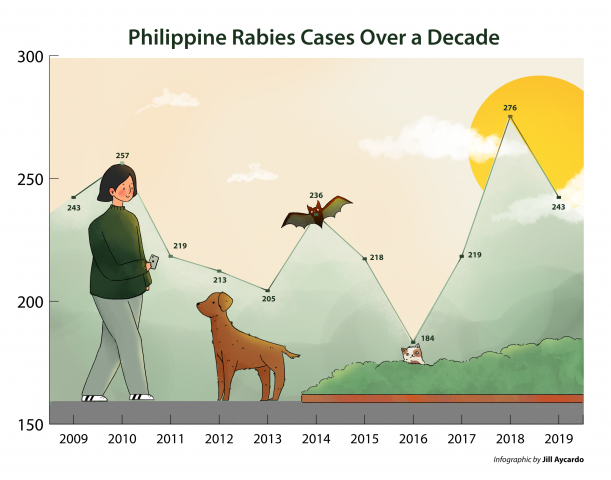“Rabies has a fatality rate of almost 100 percent…It is responsible for the death of about 200 to 300 Filipinos every year,” emphasizes Dr. Ronaldo Quintana, program manager of the National Rabies Prevention and Control Program (NRPCP) of the Department of Health (DOH) Infectious Disease Office. The disease in question causes the inflammation of the brain, modifying behavior in humans; it is transmitted by infected warm-blooded animals, such as dogs and cats, through infective material including saliva.
Although rabies is not among the leading causes of mortality and morbidity in the Philippines, Quintana states that it is “the most acutely fatal” among infectious diseases, meaning that an infection can degrade the body rapidly. This has prompted DOH to develop the Manual of Procedures and Strategic Plan for 2020-2025, which seeks to end human deaths from dog-mediated rabies by 2027 and make the country rabies-free by 2030 through preventive measures like health education and better access to vaccines.
All small things
Globally, up to 99 percent of human rabies cases are from infected dogs, with the virus usually introduced via bites or scratches, according to Dr. Moe Myat Aye, a senior consultant microbiologist of the National Health Laboratory Rabies Section. The remaining one percent of cases are acquired from non-bite exposures such as “inhalation in bat-infested caves” and person-to-person transmission through organ and tissue transplant.
Quintana explains that once a person is infected, the incubation period—the time from exposure up to the actual manifestation of rabies symptoms—takes between a month to three months on average. This duration can extend to up to more than a year, depending on certain factors such as the amount of virus excreted, severity of exposure, and location of exposure.
Symptoms like fever and abdominal pain arise during the prodromal stage, when the virus initially replicates its genetic material and exploits body cells at the striated muscle tissue where the bite or scratch occurred; at this point, the disease becomes “virtually 100 percent fatal” says the World Health Organization, as the virus travels rapidly, reaching the central nervous system and causing more severe symptoms such as hypersalivation within days. As such, Quintana advises prevention through pre-exposure prophylaxis (PrEP) especially if one is likely to be in contact with potentially rabid animals. For rabies, PrEP requires administering three shots of vaccines throughout one month.
However, if the viral replication has taken place, Aye recommends immediately taking action by applying sustained pressure to stop bleeding and washing the wound with clean water and a pH neutral soap for at least 15 minutes. Afterward, one should see a healthcare provider even in the absence of symptoms to receive post-exposure prophylaxis (PEP) to help block the virus from entering the central nervous system. PEP involves vaccinations, extensive washing and treatment of the wound, and administration of rabies immunoglobulin—providing antibodies to fight the infection until the body can produce its own—if deemed necessary.
If left untreated zero to 10 days after symptoms appear, the disease transitions toward the acute neurological state, lasting from two to seven days wherein the virus reaches the central nervous system. Eighty percent of the time, this results in furious rabies characterized by hyperactivity, hallucinations, and hydrophobia, with the patient passing away after a few days due to cardiorespiratory arrest. The other 20 percent of cases go through a slightly less intense experience with muscles gradually becoming paralyzed; patients eventually become comatose and ultimately still meet death.
A pound of prevention
Aside from the aforementioned preventative measures, there are much more essential actions to take as stated in the Manual of Procedures and Strategic Plan for 2020-2025. Along with the Department of Agriculture, Department of Interior and Local Government, Department of Education, government organizations, non-governmental organizations, and people’s organizations, DOH plans to implement various initiatives at all levels as mandated by Republic Act 9482 or the Anti-Rabies Act of 2007.

Components of the program include mass dog vaccination and health campaigns; provision of animal rabies vaccine; dog population management; training health personnel; and a central database system to automate patient records and provide real-time data to program managers.
For Sharon Bengzon-Yap, education officer at the Philippine Animal Welfare Society, the government should focus on spray and neutering campaigns, regulating dog breeding, and educating the masses. “Until now, there are a lot of people who think that rabies is part of an animal’s body [as if it] is like the venom of a snake,” she cites.
Aye and Quintana see nationwide implementation of dog vaccination as the key to achieving the goal of having no human rabies cases by 2030. However, the NRPCP budget of P900-million is insufficient for a mass vaccination program, according to the manual, so the funds are instead used to focus on PEP and PrEP. “The goal [is] attainable if the country has 100 percent awareness of rabies and vaccines; [we can eliminate] rabies in dogs by vaccination and 100 percent immunization of people,” Quintana concludes.
